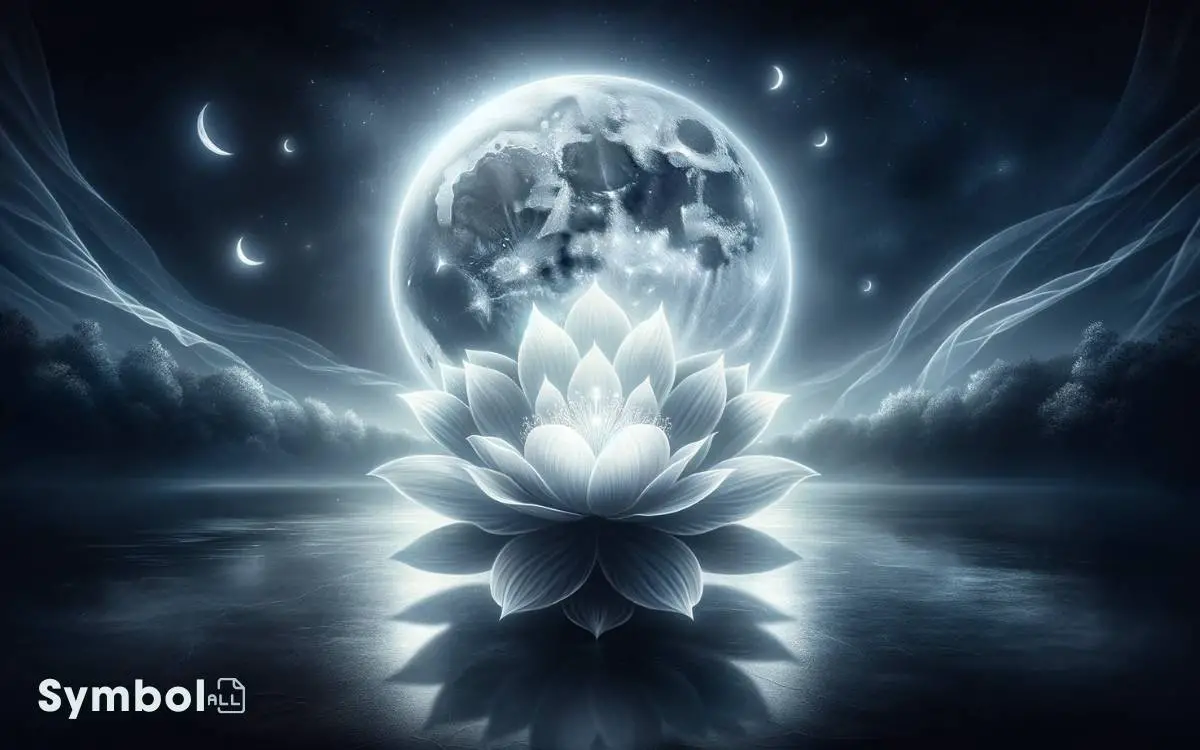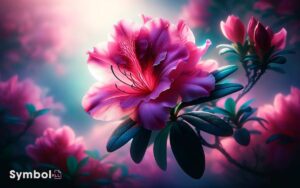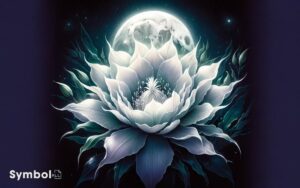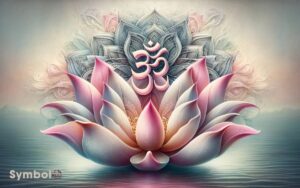What Flower Symbolizes the Moon? Jasmines!
The Moonflower embodies the moon’s mystique, revealing its blossoms under the cloak of nightfall, a process meticulously synchronized with the lunar cycle.
These nocturnal exhibitions aren’t merely for show; they’re strategic, attracting specific pollinators through their fragrant allure.
Similarly, Night-Blooming Jasmines and the White Lotus embody lunar symbolism through intense nocturnal fragrances and light-reflective qualities, enhancing visibility and facilitating pollination.
The Evening Primrose and Datura, with their twilight and moonlit enchantments, signify resilience and adaptation.
Each flower’s unique attributes whether it’s fragrance production, reflective petals, or heat regulation underscore a deep-rooted connection with the nocturnal ecosystem. Exploring these intricate relationships reveals nature’s nuanced interplay with the lunar presence.

Key Takeaways
The Enigmatic Moonflower
Blossoming under the moon’s gentle glow, the Moonflower, scientifically known as Ipomoea alba, showcases a unique nocturnal blooming process.
It intrigues researchers with its precise timing and fragrant allure. You’ll find its large, white flowers unfurling as dusk falls, a phenomenon tightly synchronized with the lunar cycle.
This adaptation isn’t just for show; it’s a strategic evolution to attract specific pollinators, like nocturnal moths, that thrive in the cool night air.
The Moonflower’s ability to regulate its blooming to such a precise window of opportunity underscores a sophisticated biological clock, mirroring the rhythms of its celestial namesake.
This precise timing guarantees successful pollination by utilizing the limited resources and pollinator activity available at night, a critical survival strategy for this species.
Night-Blooming Jasmines Allure
Night-blooming jasmines, known scientifically as Cestrum nocturnum, captivate with their intense fragrance, which becomes most potent under the cloak of darkness.
This nocturnal blooming characteristic is an evolutionary adaptation, aimed at attracting specific pollinators that are active at night, such as moths.
The mechanism behind their potent scent involves the increased production of volatile compounds as the sun sets.
These compounds, primarily consisting of esters, alcohols, and terpenes, diffuse more efficiently in the cooler night air, creating an olfactory beacon for their pollinators.
Moreover, the white color of night-blooming jasmine flowers enhances their visibility in the moonlight, facilitating the pollination process.
This intricate interplay of biological and chemical processes underscores the allure of night-blooming jasmines, making them emblematic of the mysteries and beauty of the nocturnal world.
White Lotus: Purity and Light
The white lotus, symbolizing purity and light, unfurls its petals in serene waters, embodying an elegance that has fascinated botanists and symbolists alike.
This aquatic perennial is distinguished by its remarkable ability to emerge from murky waters unblemished, a phenomenon that has led to its association with purity, enlightenment, and rebirth in various cultures.
Scientifically known as Nelumbo nucifera, the white lotus thrives in muddy, shallow ponds and lakes, a unique ecological adaptation that allows it to guarantee its temperature, akin to thermoregulation observed in certain animals.
This capability safeguards its survival and blooming even in fluctuating environmental conditions.
The white lotus’s reflective petals capture and amplify light, making it a symbol of clarity and spiritual awakening, mirroring the luminescence of the moon in tranquil waters.
Evening Primrose: Twilight Beauty
You’ll find the Evening Primrose‘s blooming habits fascinating, as they uniquely open at twilight, aligning their cycle closely with lunar rhythms.
This demonstration not only serves ecological functions but also imbues them with rich symbolic meanings tied to the moon and nocturnal renewal.
Analyzing these aspects reveals how the Evening Primrose stands as a validation to the intricate relationships between flora and celestial bodies.
Blooming Habits
Among the myriad of floral species, evening primrose uniquely unfurls its petals as dusk falls, offering a twilight beauty that epitomizes lunar symbolism. This nocturnal blooming habit, scientifically termed as ‘nyctinasty,’ serves a critical ecological function.
By opening at night, evening primrose optimizes pollination opportunities with nocturnal pollinators, such as moths. The plant’s growth cycle is intricately tied to the lunar cycle, showcasing a remarkable adaptation to its environment.
Its petals, which are tightly closed during the day, begin to open as the evening progresses, reaching full bloom under the moon’s soft light. Its delicate fragrance fills the night air, drawing nocturnal pollinators to its luminous beauty. Many have pondered the symbolism of the violet flower, often associating it with themes of mystery, devotion, and quiet strength. In the stillness of the evening, it stands as a gentle reminder of the beauty found in the understated and unseen.
This synchronized flowering not only maximizes reproductive success but also conserves moisture, reducing the risk of desiccation under the harsh daytime sun.
Symbolic Meanings
Exploring the evening primrose’s nocturnal blooming habits reveals its profound symbolism, where its twilight beauty embodies the delicate interplay between light and life, mirroring the moon’s influence over the natural world.
This phenomenon isn’t merely a botanical curiosity but a metaphor for resilience, adaptation, and the cyclic nature of existence.
To evoke emotion:
- Resilience: The evening primrose thrives in the harshest environments, symbolizing strength and the ability to overcome adversity.
- Adaptation: Its unique blooming cycle demonstrates nature’s remarkable capacity for adaptation, encouraging you to embrace change with grace.
- Cyclic Nature of Existence: The flower’s lifecycle resonates with the moon’s phases, reminding you of the constant flux in life and the beauty in renewal.
Understanding these symbols enhances our appreciation for the evening primrose, revealing deeper connections between us and the natural world.
Datura: A Moonlit Enchantment
You’ll find Datura’s ties to the moon not only in its enchanting bloom under moonlight but also in its deep-rooted mystical associations.
Analyzing its use in cultivating moon gardens reveals a blend of botany and cultural practices, highlighting its role in nocturnal pollination and symbolism.
This exploration offers insight into how Datura integrates into lunar-themed horticulture, enhancing both aesthetic and ecological aspects of gardens.
Daturas Mystical Associations
Datura plants, revered for their moonlit blooms, hold deep mystical associations, spanning various cultures and historical periods. These connections aren’t merely aesthetic but are deeply embedded in the fabric of various spiritual and medicinal traditions.
Analyzing Datura’s historical and cultural significance offers a window into its mystical allure:
- Symbolism in Rituals: Datura has been a key component in sacred rituals, symbolizing a bridge to the spiritual world due to its psychoactive properties.
- Medicinal Use and Caution: Historically, Datura was used in medicine for its antispasmodic properties, yet its use was always approached with caution due to its potent toxicity.
- Cultural Significance: Across different cultures, Datura symbolizes the impermanence of life, reminding us of the thin veil between reality and the spiritual domain.
Understanding Datura’s complex background enriches your appreciation of its mystical charm, bridging the gap between the physical and the metaphysical.
Cultivating Moon Gardens
Having unraveled the mystical allure of Datura, let’s now focus on how to incorporate this enchanting plant into moon gardens, a practice that enhances nocturnal landscapes with its moonlit blooms.
To successfully cultivate Datura, you’ll need to make sure it’s planted in well-draining soil, as stagnant water can lead to root rot. This species thrives in full sun to partial shade, requiring at least six hours of direct sunlight daily.
Its best growth temperature ranges between 60°F to 70°F. Regular watering is vital, especially during dry periods, but be mindful to avoid overwatering.
Datura’s rapid growth and large, fragrant flowers make it a standout in moon gardens, attracting nocturnal pollinators. However, remember it’s highly toxic if ingested, so exercise caution in its placement, especially in gardens frequented by pets and children.
The Gardenias Luminous Glow
Gardenias, with their luminous glow, emit a soft, radiant light under the moon, reflecting their unique adaptation to nocturnal pollination. This adaptation isn’t just a marvel of nature but a vital survival mechanism, allowing gardenias to thrive in moonlit environments.
Their white petals serve as beacons to nighttime pollinators, such as moths, facilitating a symbiotic relationship essential for reproduction.
To understand their glow, consider these points:
- Reflective Petals: The gardenia’s petals have evolved to reflect moonlight, making them visible to nocturnal pollinators.
- Fragrance Production: They emit a stronger scent at night, attracting pollinators with their intoxicating aroma.
- Heat Regulation: Gardenias can regulate their temperature, making their environment more inviting for pollinators.
These features aren’t just for survival; they symbolize resilience, adaptability, and the interconnectedness of life.
Conclusion
To wrap up, you’ve explored the garden of the night, where flowers like the enigmatic Moonflower, Night-Blooming Jasmine, White Lotus, Evening Primrose, Datura, and the luminous Gardenia thrive under the moon’s soft gaze.
Each, in its essence, mirrors the moon’s serene beauty, symbolizing purity, light, and the mystical allure of twilight.
These floral embodiments of the moonlight serve not just as botanical wonders but as celestial connectors, bridging the gap between the terrestrial and the celestial in nature’s grand tapestry.






